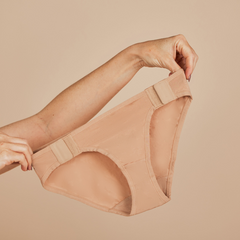Learn how to help rotator cuff pain and avoid aggravating a shoulder injury.
Rotator cuff pain can significantly impact daily activities, limiting your ability to perform tasks that involve lifting, reaching, or even simple movements of the shoulder.
Let’s explore a few ways to help manage and alleviate rotator cuff pain, from self-care techniques to ergonomic tools to simplify everyday routines.

Why Do We Get Rotator Cuff Pain?
Rotator cuff pain is usually the result of repetitive movements or shoulder injuries. It can also sometimes be degenerative and caused by aging.
Here are some common symptoms that often arise when you have a rotator cuff injury:
- Pain and tenderness in the shoulder, especially when lifting the arm.
- A feeling of weakness in the shoulder.
- Limited range of motion or tightness in the shoulder.
- A cracking or popping sensation during shoulder movement.
If you are in a lot of pain, always consult with a healthcare professional.
Self-Care Techniques
For minor injuries that don’t require rotator cuff surgery there are several self-care techniques you can try to manage rotator cuff pain.
Rest and Avoid Overuse
One of the most crucial steps in managing rotator cuff pain is to rest. This isn’t always easy but it can prevent you from aggravating the impacted shoulder.
Try to avoid activities that exacerbate the pain, especially those that involve any force whether lifting, pushing, or pulling.
Ice and Heat Therapy
Applying ice packs to the shoulder for 15-20 minutes several times a day can help reduce inflammation and numb the pain. After the initial inflammation subsides, heat therapy using a warm towel or heating pad can help relax the muscles and improve blood flow.
Gentle Stretching and Strengthening Exercises
Engaging in gentle stretching and strengthening exercises can help maintain shoulder flexibility and strength. Here are a few exercises that can help with minor rotator cuff pain.
- Pendulum Swings: Lean forward and let your affected arm hang down. Gently swing your arm in small circles.
- Crossover Arm Stretch: Gently pull one arm across your chest to stretch the shoulder.
- Wall Crawls: Stand facing a wall and use your fingers to "crawl" up the wall, slowly lifting your arm.
Ergonomic Tools
Which tools are useful if you often have rotator cuff pain?
Adaptive Clothing

Adaptive clothing has special features to simplify dressing routines and avoid overstraining the shoulder. For example, the Springrose Adaptive Bra fastens at the front and has front adjusting shoulder straps to avoid excessive twisting or reaching when dressing.
Read more: How to get dressed after rotator cuff surgery.
Shoulder Braces and Supports
Shoulder braces provide stability and support to the affected shoulder, reducing pain and preventing further injury. Look for adjustable braces that offer a comfortable fit even when the shoulder is swollen.
Support Pillows
Ergonomic pillows can provide proper neck and shoulder support during sleep, reducing strain and pain. They can help to reduce pressure on the problem shoulder.
Professional Treatments
If at-home care techniques are not providing adequate relief, it may be time to seek professional treatment.
Physical Therapy
A physical therapist can design a personalized exercise program to improve shoulder strength, flexibility, and function. They can also teach you proper techniques to avoid further injury.
Steroid Injections
In some cases, your doctor may recommend corticosteroid injections to reduce inflammation and alleviate pain. These injections can provide temporary relief and make it easier to do physical therapy.
Surgery
In more severe cases where non-surgical treatments are ineffective and the pain continues, surgery may be necessary.
Surgery can help to repair torn tendons, remove bone spurs, or address other issues causing the pain.
Your doctor will discuss the best surgical options based on your specific condition.
Lifestyle Changes to Prevent Future Pain
Preventing rotator cuff pain involves making certain lifestyle changes and adopting healthy habits.
- Maintain Good Posture: Proper posture reduces strain on the shoulder muscles and tendons and is important for those who have recurring discomfort.
- Strengthen Shoulder Muscles: Regularly perform exercises that strengthen the shoulder and surrounding muscles.
- Avoid Repetitive Movements: Take breaks and avoid repetitive shoulder movements that can lead to overuse injuries.
- Use Ergonomic Tools: Ensure your workspace and daily tools are ergonomically designed to minimize shoulder strain.



